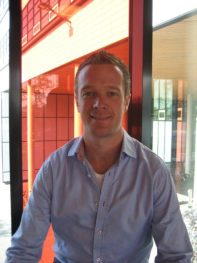Interface engineering for organic electronics
Manufacturing of hybrid inorganic-organic molecular crystal devices
Promotion date: 30. September 2011
Promotors: prof.dr.ing. Guus Rijnders, prof.dr.ing. Dave Blank
| Work on organic semiconductors has grown rapidly, mainly due to the perspective of fabricating electronic devices on large, flexible substrates at low costs. For the manufacturing of organic electronic devices (e.g. RFID tags, displays, solar cells), working with thin films is most attractive. However, structural imperfections and polycrystalline orientations limit the study of the intrinsic properties of these materials. Single-crystalline systems are studied, to provide an upper limit of the performance physically attainable. Pentacene, the benchmark material in this work, is by far the most popular organic semiconductor used in the fabrication of organic field-effect transistors (OFETs). Single-crystal morphology shows a step flow type of crystal growth as the dominant growth mechanism. Yet several observations show that the crystal growth behavior is not limited to this type of growth alone. In order to fabricate complete organic molecular single-crystal field-effect transistors, the direct deposition and patterning of various metals (i.e. Au, Pt, Pd, Ni and Co) and medium-κ oxide dielectric materials (i.e. Al2O3, HfO2 and CeO2) through a stencil on the surface of pentacene single-crystals by pulsed laser deposition (PLD) is investigated. By taking several precautions in the PLD process, that reduce the kinetic energy of the impinging species or reduce build-up of stress during deposition, low-kinetic energy deposition or ‘soft-landing’ is achieved. Finally, the influence of the deposition parameters applied in the device fabrication procedure (‘hard-landing’ vs. ‘soft-landing’) and the influence of performing a heat treatment (before applying the metal contacts) on the electrical properties of pentacene single-crystals is investigated |
Was your thesis work fundamental or also application-oriented?
I think my thesis work has both fundamental and application-oriented aspects. This was also one of the reasons why I choose to work on this project.
The material properties are important to understand when in future electronic applications using organic semiconductors are more feasible. An important step then is to deal with the oxidation properties of the materials involved during manufacturing in a smart way.
My work was part of the NanoNed program. We collaborated for example with the University of Groningen. The Solid State Chemistry group offered us the grown organic single-crystals we used as a starting point for our investigations. Professor Palstra is an expert in this area.
In Twente we are specialized in growing and patterning thin films of various materials, by the pulsed laser stencil deposition technique. The ‘soft-landing’ principle, to pattern structures on the fragile crystals, worked out very well in the end.
In the last period we combined the techniques used, in building complete field effect transistors on the surface of the organic crystals. Further research is necessary to bring the steps together to come to more robust results.
What are your future plans?
Right now I am working at MASER Engineering. The techniques I learned in my thesis project, I can now use and further expand in the experiments there, for example to test IC-components of micro-electronic products and predict their lifecycle.
Interesting feature of this job is, I am offered to further develop my soft skills by coordinating European projects MASER Engineering is involved in.
What is working at Mesa+ like?
Being able to visit and present my own research at international conferences was really inspiring. One can actually meet and talk to the top scientists one knows from studying literature. Getting to know them and their ideas, and discuss my own work with the experts from all over the world, was really great.
Also I like the working attitude at Mesa+. As a PhD I learned to operate most of the equipment myself.
What, in your opinion, is important for Mesa+ to stay successful in future?
I think the institution is on the right track. Especially the Mesa+ day is very inspiring. Also the spin off´s are of special importance. In this way Twente is put on the map nationally and internationally.
The monthly colloquia were very specialized most of the time, its impact depending heavily on the presentational skills of the speaker. Making these meetings more accessible would be a big improvement in my opinion.

